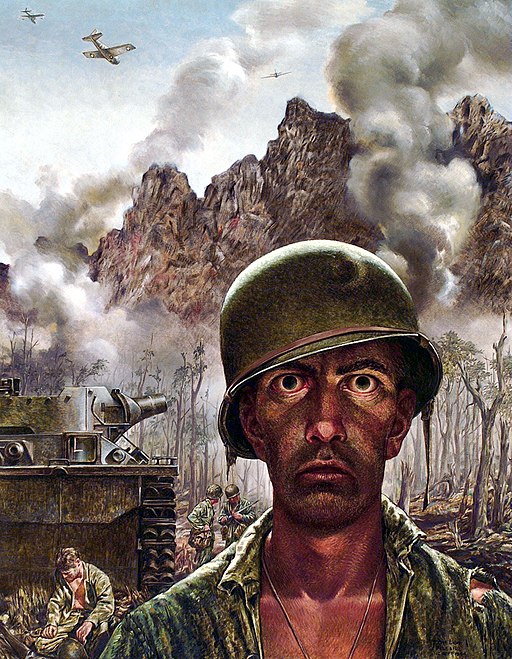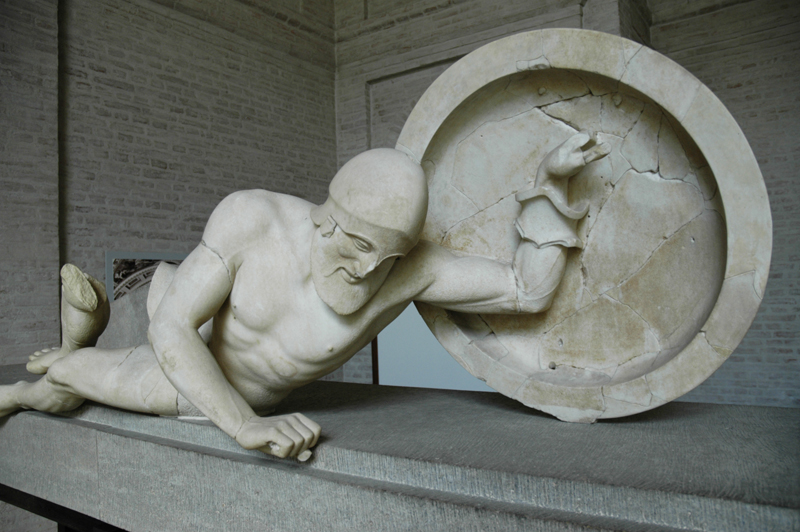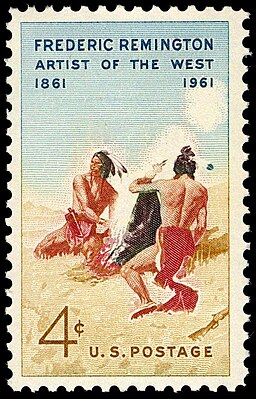
“The Smoke Signal” by Frederic Remington depicts three Plains Indians sending a smoke signal using a blanket and white smoke. In general smoke signals, were used to transmit an agreed message, signal danger, or gather people to a common area.
North American indigenous peoples communicated via smoke signal, and each tribe had its own signaling system and understanding. A single smoke, ascending naturally, was usually a warning to all Indians that strangers are approaching.
A signaler started a fire on an elevation typically using damp grass, which would cause a column of smoke to rise. The grass would be taken off as it dried, and another bundle would be placed on the fire.
The location of the smoke along a hill’s incline conveyed a meaning. If it came from halfway up the hill, this would signify all was well, but it would signify danger from the top of the hill.
The Native Americans used buffalo chips or prairie grass for fire and smoke as a practical system for sending messages, especially if the terrain between the two parties was hilly or covered by trees.
An 1882 published account described the process:
“A small fire is built on which is placed damp grass, creating a large volume of smoke.
As it begins to ascend, a blanket is held horizontally above it,
and when space beneath is quite full, the blanket is slipped off sideways and then quickly brought back to its place.
Smoke managed in this way ascends in round puffs, miniature clouds, one meaning one thing, two another.”
“The Smoke Signal” by Frederic Remington depicted this operation. A signal fire was made on the side or the top of a high hill, away from water sources. This was done to ensure that the signal can be distinguished from the smoke of a campfire.
The rifles in the foreground and feathered headdress indicate that the Crow warriors who have stripped themselves to essential clothing and weapons are a war party.
As essential as the rifles were the horses of the Plains Indians. The horses are shown with bobtails in which the tied horses’ tails are tied with feathers indicating their role in the upcoming battle.
The red handprint on the horse’s rump signified that its rider had ridden over an enemy in battle.
The Smoke Signal was made into the first reproduced artwork in full color in a commemorative 4 cent stamp in 1961 to celebrate Remington’s birthday.
US 4 cent Postage stamp, F. Remington Artwork, 1961, Designed by Charles R. Chickering
Plains Indians
Plains Indians of the Great Plains are the Native American tribes who lived on the Great Plains in North America. While hunting-farming cultures have lived on the Great Plains for centuries before European contact, the region is known for the horse cultures that flourished from the 17th century.
The introduction of the horse by Spanish explorers revolutionized Plains culture. When horses were obtained, the Plains tribes rapidly integrated them into their daily lives.
Their historic nomadism and armed resistance to domination by the government made the Plains Indian culture groups an archetype in Native Americans’ art.
The horse enabled the Plains Indians to gain their subsistence with relative ease from the seemingly limitless buffalo herds. They were extravagantly fond of their horses and the lifestyle they enabled.
History of the Smoke Signal
The smoke signal is one of the oldest forms of long-distance communication. It is a form of visual communication used over a long distance.
In ancient China, soldiers stationed along the Great Wall would alert each other of impending enemy attack by signaling from tower to tower.
Polybius, a Greek historian, devised a more complex system of alphabetical smoke signals around 150 BCE, which converted Greek alphabetic characters into numeric characters. It enabled messages to be easily signaled by holding sets of torches in pairs.
Today, the College of Cardinals uses smoke signals to indicate a new Pope’s selection during a papal conclave. The ballots are burned after each vote. Black smoke indicates a failed ballot, while white smoke means a new Pope has been elected.
Colored smoke grenades are also commonly used by military forces to mark positions, especially during calls for artillery or air support.
Smoke signals also used in smoke-producing devices used to send distress signals.
“The Smoke Signal” by Frederic Remington
- Title: The Smoke Signa
- Artist: Frederic Remington
- Date: 1905
- Medium: Oil on canvas
- Dimensions: 122.6 x 77.1 cm
- Category: American Artist
- Museum: Amon Carter Museum of American Art
Frederic Remington
Frederic Sackrider Remington (1861 – 1909) was an American painter, illustrator, and sculptor specializing in the American Old West’s depictions.
Remington’s artworks depict the Western United States at the end of the 1800s, featuring such images as cowboys, American Indians, and the United States Cavalry.
His style was naturalistic, sometimes impressionistic, and his focus was on the West’s men and animals, with landscape usually of secondary importance.
Frederic Remington
- Name: Frederic Sackrider Remington
- Born: 1861, Canton, New York
- Died: 1909 (aged 48), Ridgefield, Connecticut
- Nationality: American
- Specialty: American Old West.
- Notable Works:
- The Smoke Signal
- A Dash for the Timber
Frederic Remington
A Virtual Tour of American Artists You Should Know
- John Singleton Copley (1738 – 1815)
- Benjamin West (1738 – 1820)
- Gilbert Stuart (1755 – 1828)
- John Trumbull (1756 – 1843)
- George Caleb Bingham (1811 – 1879)
- Frederic Edwin Church (1826 – 1900)
- James Abbott McNeill Whistler (1834 – 1903)
- Winslow Homer (1836 – 1910)
- Mary Cassatt (1844 – 1926)
- Daniel Chester French (1850 – 1931)
- John Singer Sargent (1856 – 1925)
- Childe Hassam (1859 – 1935)
- William McGregor Paxton (1869 – 1941)
- George Bellows (1882 – 1925)
- Edward Hopper (1882 – 1967)
- Grant Wood (1891 – 1942)
- Norman Rockwell (1894 – 1978)
A Brief History of Western Art
~~~
“The Indians are most enlightened, for they have at least one distinct impression regarding government. They know that it never keeps its word.”
– Frederic Remington
~~~
Photo Credit: 1) Frederic Remington, Public domain, via Wikimedia Commons.; Bureau of Engraving and Printing ; Designed by Charles R. Chickering, Public domain, via Wikimedia Commons
Popular this Week








 Sponsor your Favorite Page
Sponsor your Favorite Page SEARCH Search for: Search Follow UsJoin – The JOM Membership Program
Sponsor a Masterpiece with YOUR NAME CHOICE for $5
Share this:
- Tweet

